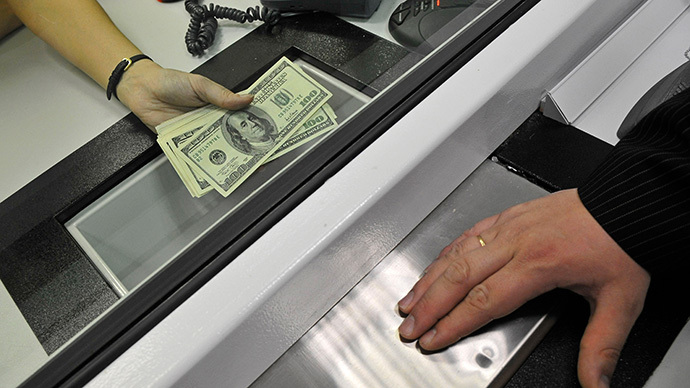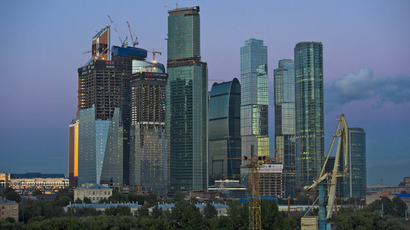Russian lawmaker seeks to ban US dollar, predicts 2017 collapse

To protect Russians against the “collapsing US debt pyramid”, a Russian legislator has filed a draft bill to ban circulation of the currency in Russia.
Once a Moscow mayoral hopeful, Mikhail Degtyarev, 32, likens the US dollar to a worldwide ponzi scheme which he says is scheduled to end in 2017.
“If US national debt continues to grow at its current rate,
the dollar system will collapse in 2017,” the submitted draft
legislation says.
“In light of this, the fact that confidence in the US dollar
is growing among Russian citizens is extremely
dangerous,” Degtyarev wrote in his explanatory note attached to the bill.
The bill would impose a ban on dollars within a year of its passage, and any private citizen holding accounts in dollars would either need to spend the money or convert it to another currency. There is no proposed ban on the euro, British pound, yen, or yuan.
If one doesn’t exchange or transfer dollars within a year, the
dollars will be seized by officials, and reimbursed in rubles
within 30 calendar days.
Under the proposed legislation, Russians would still be able to
use dollars abroad and have foreign bank accounts, as well as buy
goods on the Internet in dollars.
The Russian government, Central Bank, Foreign Ministry, Federal
Treasury, Federal Security Service, and other state branches
would be exempt from the law.
To protect Russian nationals, Degtyarev proposes to end dollar
transactions and deposits at Russian banks, which would give rise
to the ruble, and end dependence on the world’s dominant
currency.
Part of the bill aims to restore the prestige of the ruble, which
has weakened as the Russian economy battles inflation and slow
growth.
Raising the prestige of the ruble by nixing foreign currency
isn’t a novel idea- it was practiced during the Soviet Union when
holding foreign currencies was illegal. A similar ‘anti-dollar’
proposal was filed by Duma deputies in 2003, but completely
flopped.
Moscow, a developing financial center, is
home to several international corporations, and many companies
pay their employees in dollars, or ruble salaries pegged to the
dollar.
If the bill garners enough support, it will continue onto as many
as three preliminary hearings before being passed into law.
Degtyarev has made a name for himself with his outlandish proposals- from giving women extra
holidays during menstruation, to his declaration Russia would
lead the fight in defeating the antichrist. He serves as the head
of the science and technology committee in the lower house of the
Duma.
The populist Liberal Democratic Party (LDPR) is a political
platform for Vladimir Zhirinovsky, who is famous for political
antics.
On the same day, November 13, Belarus issued a statement denying rumors they were mulling a similar currency ban, after an opposition group reported a currency circulation ban that would get rid of dollars and euros in two months.
Citing Alexander Timoshenko, a representative of the Belarus
National Bank, Interfax reported the rumors were “absolute
nonsense” for a country with an open economy.
Dollars in demand
Public demand for foreign banknotes in Russia, especially dollars, has greatly increased as the ruble continues its slow devaluation.
The Russia’s Central Bank (CBR) said they believe the ruble has stabilized, but that hasn’t curbed investors, both private and public, to not put all their rubles in one basket.
The aggregate demand for foreign currency in September
2013 increased $9.1 billion, up 7 percent from August,
according data from the the Bank's September 2013 Review of State
and Domestic Foreign Currency Market report, available on its
website.
The Bank has allowed the ruble to flow more freely to accommodate foreign investment and financial markets, but this has created a tough inflation balancing act for the CBR.
Demand for dollars in September 2013 rose $5.9 billion, up 11
percent from August. Over the last year, aggregate demand for
dollars has dropped 1 percent, but has jumped 12 percent by
individuals' purchase and conversion of greenbacks.
The ruble’s daily trade range is 32.45–39.45, which the regulator
increased on Tuesday. The bank buys between $200 and $400 million
in rubles per day to counter losses. At 20:15 Moscow time, the
ruble was trading 32.7643 per one US dollar.
Consumer prices rose 6.3 percent from October, year-on-year, which is within the bank’s target inflation range of 5-6 percent. Inflation fears have prevented the bank from cutting the official interest rate for the last 14 month.
Over $13.3 billion in foreign currency flowed into (bought, acquired) authorized Russian banks in September, and nearly $13.1 billion flowed out.
In foreign currencies, total demand for the dollar in September was 65 percent, and 34 percent for euros.














